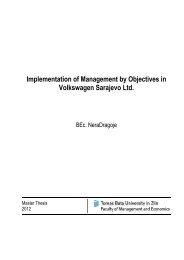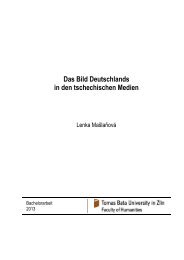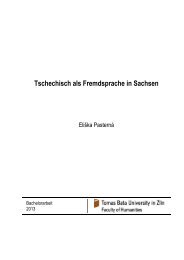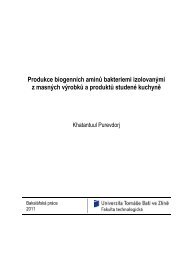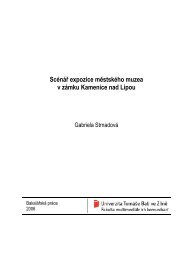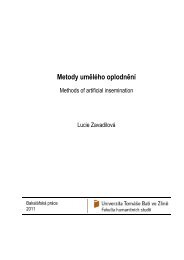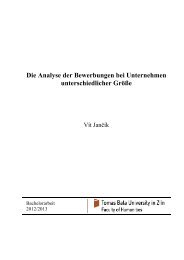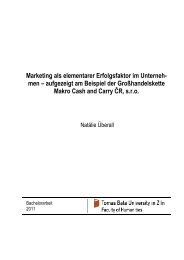The study of using of nanofillers in polyolefinic matrix - DSpace UTB
The study of using of nanofillers in polyolefinic matrix - DSpace UTB
The study of using of nanofillers in polyolefinic matrix - DSpace UTB
Create successful ePaper yourself
Turn your PDF publications into a flip-book with our unique Google optimized e-Paper software.
Tomas Bata University <strong>in</strong> Zlín, Faculty <strong>of</strong> Technology<br />
Dellite 72T prepared which condition <strong>of</strong> preparation was 80 rpm at 40 m<strong>in</strong>. <strong>The</strong> dependence<br />
<strong>of</strong> tensile strength on concentration <strong>of</strong> nan<strong>of</strong>iller showed that nanocomposites (condition <strong>of</strong><br />
preparation was 10 m<strong>in</strong> at 80 rpm) conta<strong>in</strong>ed Dellite 72 T had almost the same level <strong>of</strong> tensile<br />
strength to the contrary to polypropylene filled with Dellite 67 G. However, all measured data<br />
<strong>of</strong> mechanical tests were higher than value <strong>of</strong> unfilled polymer <strong>matrix</strong>. <strong>The</strong> optimal conditions<br />
<strong>of</strong> preparation were determ<strong>in</strong>ed from 3D graph. 3D graph was constructed from data <strong>of</strong> tensile<br />
strength, time <strong>of</strong> compound<strong>in</strong>g and speed <strong>of</strong> rotation. Optimal condition was determ<strong>in</strong>ed to 30<br />
m<strong>in</strong>. and 60 rpm.<br />
Last publication, Polyolef<strong>in</strong>/Clay Nanocomposites: Comparison <strong>of</strong> Different Types <strong>of</strong><br />
Fillers and Us<strong>in</strong>g <strong>of</strong> Mathematic Model, studied the possibility <strong>of</strong> <strong>us<strong>in</strong>g</strong> <strong>of</strong> another type <strong>of</strong><br />
filler <strong>in</strong> polypropylene <strong>matrix</strong> and application <strong>of</strong> mathematic model. Polymer <strong>matrix</strong> was<br />
based on polypropylene material. Two types <strong>of</strong> nan<strong>of</strong>illers (Dellite 72 T and Dellite 67 G)<br />
were completed micronized calcium carbonate Omya 1 SP. Laboratory kneader Brabender PL<br />
2000 was used for preparation. <strong>The</strong> conditions <strong>of</strong> preparations were various (speed <strong>of</strong> rotation<br />
was 40 and 60 rpm, time <strong>of</strong> compound<strong>in</strong>g was 30 m<strong>in</strong>). <strong>The</strong> concentrations <strong>of</strong> fillers were 2,<br />
4, 6, 10, 20 and 40 wt. %. Maleic anhydride polypropylene was used as compatibilizer and the<br />
concentration was 5 wt. %. Prepared (nano) composites were evaluated from morphological<br />
and mechanical po<strong>in</strong>ts <strong>of</strong> view. <strong>The</strong> morphology was represented by X-ray diffraction and<br />
electron microscopy. Mechanical tests evaluated changes <strong>of</strong> tensile and yield strength.<br />
Nanocomposites conta<strong>in</strong>ed 4 wt. % <strong>of</strong> Dellite 72 T had poor distribution and dispergation<br />
which was shown <strong>in</strong> X-ray pattern. This theory was supported by TEM and SEM pictures.<br />
Pictures showed agglomerates <strong>of</strong> fillers <strong>of</strong> nan<strong>of</strong>iller. Composites which were filled by<br />
micronized calcium carbonate conta<strong>in</strong>ed some agglomerates which size was about 1 μm.<br />
However, worst dispergation or distribution <strong>of</strong> fillers did not <strong>in</strong>fluence mechanical properties<br />
because all prepared (nano) composites had higher value <strong>of</strong> tensile or yield strength. It is<br />
<strong>in</strong>terest<strong>in</strong>g that composite filled by 20 wt. % <strong>of</strong> micronized calcium carbonate had higher<br />
mechanical properties than unfilled polymer material. <strong>The</strong> maximum <strong>of</strong> tensile strength was<br />
measured for polypropylene filled with 6 wt. % <strong>of</strong> micronized calcium carbonate and Dellite<br />
72 T. Both samples were compounded 30 m<strong>in</strong>. and speed <strong>of</strong> rotation was 40 rpm. <strong>The</strong> second<br />
chosen condition <strong>of</strong> mix<strong>in</strong>g was 60 rpm at 30 m<strong>in</strong>. <strong>The</strong> results were different than previously<br />
condition. <strong>The</strong> maximum <strong>of</strong> tensile strength was obta<strong>in</strong>ed for samples conta<strong>in</strong>ed 10 wt. % <strong>of</strong><br />
~ 26 ~



